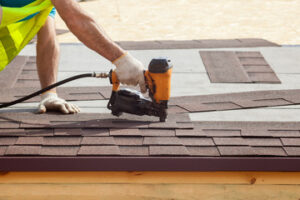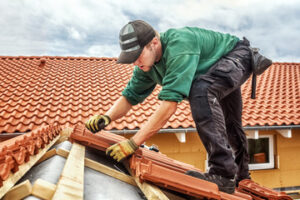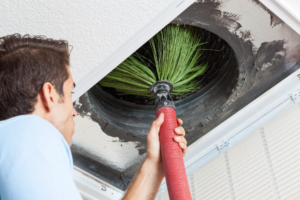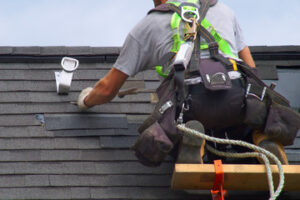As the first line of defense against sun, rain, snow and extreme temperatures, the roof is an essential part of any building. Without it, a home or business will suffer from leaks, mold, mildew and higher heating and cooling bills.

If there is severe damage to the decking and underlayment of the roof, any credible roofing company will recommend a full replacement.
Roof replacement is one of the most expensive home improvement projects. On average, homeowners spend $5,700 to $16,000 to replace an asphalt shingle roof. The exact amount you’ll spend depends on the type of roof and your location, as well as whether you opt for a full or partial replacement. It’s also important to factor in the cost of any associated costs, such as a soffit and fascia replacement, gutter installation, or skylight installation.
A new roof typically requires removal of the old shingles and felt paper or moisture barrier. This can add an additional $500 to $1,000 to the total cost. In addition, if the underlying decking or trusses are damaged during the tear-off process, you may need to replace them. This can increase the cost by $2 to $5 per square foot of the roof, depending on the material.
If the damage is limited to a few loose or missing shingles, opting for repairs can be a more cost-effective solution. However, if the damage is extensive or the roof is nearing the end of its lifespan, it’s worth considering a replacement.
Homeowners can pay for a new roof entirely upfront if they have the savings. They can also use a home equity loan or line of credit to finance the project. Both options can offer a lower interest rate than a traditional mortgage. However, it’s important to remember that you are essentially borrowing against the value of your home. If you are unable to make your payments, you could lose your home.
Another option is to use a portion of your existing homeowners insurance policy to cover the cost of a new roof. Homeowners insurance covers damage to the roof as long as it was not caused by negligence. For example, if a hailstorm knocks over some shingles, the insurance company will usually cover the cost of replacing them. You can also purchase a separate roof warranty to cover the cost of repairs or replacement. These warranties typically have a 10- to 30-year term and can be expensive, but they are well worth the investment.
Materials
The type of roof material you choose can have a significant impact on the lifespan, durability, and cost of your new roof. Fortunately, there are many options for different climates and preferences. These include asphalt shingles, wood shingles, clay and concrete tiles, metal roofing, solar roofs, and living roofs. Each offers unique benefits, so it is important to consult with a professional before making your final decision.
The most popular residential roofing material is the asphalt shingle. It is affordable, durable, and offers a wide range of color and style options. It is also available with a reflective surface that can help lower your home energy costs. However, the shingle can become brittle as it ages, so it’s important to have it replaced as needed.
If you want a more traditional look for your home, wood shingles or shakes are an excellent choice. They provide a rustic aesthetic and can be made from cedar, pine, or spruce. These types of shingles are more expensive than asphalt shingles, but they offer excellent insulation and longevity. Additionally, wood shingles can be used to repair leaks or replace damaged areas.
Tile roofs can add a beautiful aesthetic to your home and can last for more than 100 years. They are available in a variety of colors and styles, including unglazed terra-cotta clay or factory-fired glaze. They are more expensive than asphalt shingles, but can save you on energy costs.
In addition to the actual roofing materials, you’ll need to pay for any associated expenses. These may include demolition and disposal of the old roof, as well as any permits you need to obtain. Also consider the cost of ice and water barriers, flashing, and insulation.
Another thing to consider is how the material you choose will affect the value of your home. Upgrading your roof to a higher-quality material can increase the value of your home, and it will also improve its curb appeal. If you’re considering a home remodel, be sure to talk with a professional about the type of roof that would best suit your needs.
Installation
A new roof doesn’t just protect your home from storms; it can also add value to it. That’s why it’s so important to work with a roofing expert to ensure your roof is installed correctly and will perform well for years to come.
The first step in the process is inspecting your current roof and making a plan. A craftsperson will look at the structure of your roof, its pitch (angle), and any features like chimneys and skylights to determine whether a repair or replacement is the best course of action. They will also give you a quote at this point.
Before starting the roof installation, your contractor will set up a job site. This will include protecting your property with tarps and moving any objects that could get damaged during the tear-off. This includes outdoor furniture, ceramic landscaping features, and even satellite dishes. They will also need to trim back any tree branches that hang over the roof.
Once the job is started, your roofing crew will begin removing the old shingles in sections. This helps to prevent damage to the existing decking underneath and allows the crew to keep moving forward without having to stop. They will start on the side or section of your house that is furthest away from the driveway. This way they can always be moving closer to their dump trailer and new materials. They will also be able to quickly begin installing the new shingles in that section of your roof.
After the old shingles are torn off and removed, the crew will remove any debris that’s left on your roof. This includes loose granules, nails, and other roofing material. They will also clean out your gutters so they’re free of blockages.
When the new roof is installed, the contractors will go over it to make sure everything looks good. This will also be a good time to discuss any questions or concerns you may have. They will also check with your local government to make sure that all the necessary permits have been obtained.
While it might seem like a lot of work to have your roof replaced, the payoff is huge. A new roof will improve your home’s curb appeal and increase its resale value. And, if properly installed by a professional roofing company, it will provide decades of protection for your family and belongings.
Warranty
A roof is a major investment, and one that needs all the protections it can get. With manufacturer and workmanship warranties, you can have confidence that your roof is well-taken care of and will last for decades.
Roofing warranties can vary, but the most important thing to look for is whether or not they are full or limited. A full warranty guarantees that during the period of the warranty, any defective parts will be repaired or replaced free of charge. Limited warranties typically have exclusions or specific parts not covered.
You should also check if your warranty is transferable to a new homeowner once the contract ends. This is an excellent way to protect your investment and give you peace of mind that if you ever decide to sell your home, the new homeowner will have protections from any problems with the roof.
When choosing a contractor, be sure to ask about the length of their workmanship and manufacturer’s material warranties. Workmanship warranties typically range from 10 to 30 years, while material warranties can last between 25-30 years. Regardless of the duration of the warranty, you should compare it to other contractors’ offerings and make sure that they are competitive.
It is also important to note that most manufacturers will not honor a warranty if the materials were installed by someone who is not a certified installer. For example, Owens Corning and GAF do not allow their materials to be used by non-certified contractors. Therefore, it is important to find a contractor who is both certified and offers a workmanship warranty.
Keep in mind that most warranties do not cover cosmetic issues, such as dents and scratches. Additionally, most warranties are not valid for mechanical issues beyond the first year of installation. Finally, you should be aware that your warranty may be voided for failing to conduct regular maintenance. The most common reasons a warranty is void include not having the roof regularly inspected and cleaned, hiring a different contractor for maintenance or repairs, and neglecting to register your warranty.
Getting the most out of your roof replacement requires a commitment to maintain it on a regular basis. By keeping a calendar reminder and using a professional for maintenance and repairs, you can prevent costly damage and keep your warranty in effect for the long haul.








